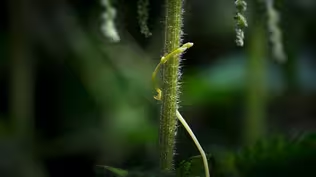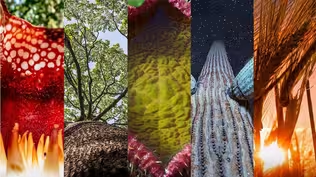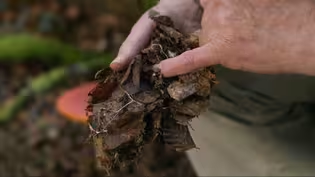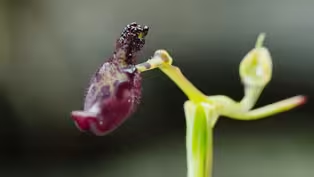
Seasonal Worlds
Episode 3 | 55m 55sVideo has Audio Description, Closed Captions
Sir David Attenborough reveals the surprising effects of the seasons on plant life.
Sir David Attenborough reveals the surprising and dramatic effects of the four seasons on plant life. In order to survive the huge challenges each season presents, plants must use strategy, deception and remarkable feats of engineering.
See all videos with Audio DescriptionADProblems playing video? | Closed Captioning Feedback
Problems playing video? | Closed Captioning Feedback

Seasonal Worlds
Episode 3 | 55m 55sVideo has Audio Description, Closed Captions
Sir David Attenborough reveals the surprising and dramatic effects of the four seasons on plant life. In order to survive the huge challenges each season presents, plants must use strategy, deception and remarkable feats of engineering.
See all videos with Audio DescriptionADProblems playing video? | Closed Captioning Feedback
How to Watch The Green Planet
The Green Planet is available to stream on pbs.org and the free PBS App, available on iPhone, Apple TV, Android TV, Android smartphones, Amazon Fire TV, Amazon Fire Tablet, Roku, Samsung Smart TV, and Vizio.

The Green Planet
Dive into the extraordinary world of plants with articles from The Green Planet.Providing Support for PBS.org
Learn Moreabout PBS online sponsorship[Music] ♪ ♪ ♪ ♪ ♪ ♪ David Attenborough: This is the boreal forest... ♪ the largest forest on Earth... 750 billion trees... ♪ smothered by snow throughout the winter.
♪ This is the northernmost boundary of an extraordinary world.
♪ I'm standing at the edge of the Arctic Circle.
To the north of me lies a land dominated for most of the year by snow and ice; 3,000 miles to the south, the tropics, bathed the year round in warm sunshine; and, in between, a very different world, dominated by relentless change.
♪ An endless cycle of four distinct seasons, each with its own challenges.
The short, freezing days of winter give way to the urgent awakening of spring... ♪ and the long, hot days of summer yield to the cooling of autumn.
♪ Opportunities will be brief.
♪ To survive these extremes, plants have not only got to be hardy and resilient, but many of them have developed special strategies in order to meet the demands of this seasonal world.
[Music with sound of clock ticking on soundtrack] To succeed, they must get their timing just right.
♪ For months now, this world has been asleep, but change is coming.
♪ ♪ Spring is on its way.
♪ ♪ ♪ In Canada, the forests are starting to stir.
Throughout the winter, the sugar maples here have kept stores of nutrients ready for this moment.
♪ Now, as temperatures start to rise, those nutrients must be brought up from the roots.
♪ Sap is on the rise... ♪ fuel for new green growth.
♪ But just as growth reaches full speed, robbers arrive.
[Thudding] [Cracking] [Pecking] ♪ ♪ A sapsucker, a thief in search of maple syrup.
♪ ♪ The tree can tolerate hundreds of wounds... ♪ but if they completely encircle the trunk, the tree will eventually die.
[Loud thud] ♪ The sapsucker's break-in hasn't gone unnoticed.
♪ Hummingbirds, squirrels... and insects all invade the sapsuckers' territory, trying to steal a meal.
♪ But, unwittingly, they help the tree.
♪ [Sapsucker calling] Time spent chasing the competition... ♪ means less time to drill new holes.
♪ [Birds squawking] ♪ ♪ The tree gets a chance to repair its wounds... ♪ and the sap can rise freely again.
♪ So this year, at least, the tree will once more produce its leaves... ♪ hundreds of miniature solar panels that collect energy from the sunlight.
♪ Each leaf is covered by millions of microscopic pores, stomata.
♪ They take in carbon dioxide and release oxygen and water vapor in a process that produces high-energy fuel.
♪ [Animals calling] All the trees here can now use that fuel to grow over the coming months.
♪ ♪ As spring proceeds, the power of the sun increases.
On riverbanks across Europe, many plants have been lying dormant underground... waiting for the earth to warm.
♪ And now a race begins.
♪ Among the first to start are nettles, the sprinters.
♪ Then, only just behind, come the brambles.
They're much more aggressive and have backward-pointed hooks with which to scramble over their rivals.
♪ Last to come, the climbers... ♪ hops and bryony.
♪ They lasso their way towards the light.
♪ ♪ ♪ Soon, every inch of space and every patch of light has been claimed.
♪ But hidden in the shadows, another plant has been waiting to make its move.
♪ This is dodder... ♪ a hunter... ♪ with an exceptional sense of smell.
♪ Moving swiftly, it searches for its prey.
♪ It detects the scent of a young nettle.
♪ ♪ The dodder punctures the nettle's stem and sucks out the nutritious sap.
♪ And it doesn't stop at just one victim.
♪ With its energy supply assured, it multiplies.
♪ It's a parasite with an insatiable appetite.
♪ ♪ ♪ ♪ ♪ ♪ [Bird squawks] But remarkably, its victims can now exploit the dodder when other springtime enemies appear... ♪ caterpillars.
♪ ♪ When under attack, a leaf sends out a signal telling the rest of the plant to start building defenses... ♪ foul-tasting toxins that deter the caterpillars.
♪ In an extraordinary twist, the stems of the dodder interconnecting the plants are now being used as lines of communication to relay these warning signals from plant to plant.
♪ They respond by producing their own protective chemicals.
♪ Eventually, the whole riverbank becomes one huge defensive network, and the one-time rivals are now better off together.
♪ ♪ ♪ The first warm days of spring encourage some plants to flower and get ahead of the competition, creating beautiful displays throughout the seasonal world... ♪ from the spectacular cherry blossoms of Japan... ♪ to the goldfield flowers of California.
♪ But spring flowering is risky.
If they flower too early, it may not be warm enough for pollinating insects to be active.
But the common daisy gives them every opportunity.
♪ The warmer the flowers are, the more attractive they are, and they have a remarkable strategy in order to maximize this.
They were closed up tightly throughout the night as a protection against the elements, but once they feel the warmth and the light of the sun, they spring into action.
♪ ♪ It's a behavior called heliotropism.
They turn to keep facing the sun, absorbing as much heat as they can.
♪ ♪ This is a thermal camera, and it will tell me the difference between the surrounding temperature and the temperature in the center of a daisy flower.
The surroundings, 12 degrees.
In the center of a flower, 21.
[Buzzing] Pollinators, such as bees and wasps, prefer the warmed-up flowers because they can get a share of the heat for themselves.
As a consequence, they can collect more nectar from more flowers, pollinating as they go.
And the daisies, with the help of their pollinators, are able to have a particularly long flowering season.
[Buzzing] But when the window of opportunity is brief, even more ingenious tactics are necessary.
♪ ♪ Here in southwestern Australia, summer temperatures can soar to up to 100 degrees Fahrenheit.
♪ ♪ Now, for a brief moment in the cooler spring, flowering plants must get busy.
♪ And this hammer orchid with its strange flower is doing exactly that.
♪ It needs to attract a pollinator but has no nectar and doesn't even look like a flower... ♪ unlike these neighboring huge grass trees.
♪ These produce thousands of tiny white flowers, all dripping with nectar.
♪ But the orchid has a different strategy.
♪ It synchronizes its emergence with the brief mating season of the thynnid wasp.
The flightless female wasp produces pheromones to attract males.
♪ This male detects a scent that seems to be hers... ♪ yet flies right on by.
♪ The orchid not only has the same shape and color as a female wasp, but it sits at the same height as she does.
It even mimics her smell... ♪ and the beguiled male attempts to mate with it.
♪ ♪ He hammers against the orchid's pollen sacs... ♪ and the wasp leaves, doubtless a little shaken... ♪ only to be duped once again.
♪ ♪ The pollen on his back now sticks to this different orchid, and the deception has worked.
♪ The orchid's imitation is even more intoxicating, it seems, than the real thing.
♪ ♪ ♪ Eventually, the male wasps tire of the orchid's enticements.
♪ Now the wasps, both male and female, find the flowers of the grass trees to feed... ♪ and there, at long last... ♪ they mate.
♪ And as for the hammer orchid, pollination is complete.
♪ ♪ As summer approaches, the need to flower becomes more urgent, and nowhere more so than here in South Africa.
♪ [Birds chirping] This is the fynbos, part of the Cape Floral kingdom, a great expanse of open heathlands just north of the Cape.
Here, there are more different species of plant than anywhere else in the world.
Nearly 9,000, many needing pollinators.
They compete with one another for such help by flaunting extravagant shapes and vivid colors, all promising nectar as a sugary reward.
But there is a plant here that avoids this crowded competition.
[Wind gusting] And the rising temperatures of summer bring just what it needs.
[Fire crackling] ♪ ♪ ♪ This is the first fire here for 15 years.
♪ Nearly all the plants are destroyed... ♪ incinerated.
♪ It might seem from the smoke and the still-smoldering embers that no plant could survive such an inferno.
♪ But just 4 days after the flames, rising from the ashes... ♪ a fire lily.
♪ It has been lying dormant underground for 15 years, but now, awakened by the smoke, it flowers.
♪ The blooms may be small and unshowy, but that's all they need to be.
♪ In this charred landscape, pollinators, such as these sunbirds, can spot these little red beacons from great distances.
They're the only source of nectar around.
And the more visitors the flowers attract, the more likely they are to be pollinated.
[Sunbird chirping] It's just in time.
♪ Within a few months, the whole landscape is alive once more.
♪ In fact, all these plants need fire to survive.
♪ And as competitors return, the fire lily fades.
♪ It now returns underground and will rest there as a bulb until another fire awakens it.
♪ By the time the long, hot days of summer arrive, wildflower meadows are bursting with life... ♪ but autumn is not far away.
So now, pollinated plants must use their remaining energy to produce the next generation: seeds.
♪ A dandelion clock contains around 200 seeds... ♪ each with its own tiny parachute.
♪ Few seeds can fly as far as these.
Some are known to have traveled over 60 miles.
♪ But to travel any distance at all, they need the wind to be just right.
However, before they can get away, there is a risk.
Voracious hunters live in this meadow... ♪ ♪ ♪ tiny harvest mice.
♪ They love dandelion seeds... ♪ but they don't like to share.
♪ Finally, the sun warms the ground, and a gentle breeze blows in, creating an ideal updraft.
♪ ♪ Air flowing between the bristles creates a vortex that lifts the seeds up.
♪ Heading off on a gentle breeze, this seed now starts its travels.
♪ ♪ ♪ ♪ Plants use a variety of different techniques to spread their seeds as far as possible from themselves, and one of the most remarkable is this one.
It's called Ecballium, and it's a relative of the cucumber.
For several weeks now, pressure has been building up inside the pods, and so now they're as taut as a well pumped-up bicycle tire.
All they need is just a slight nudge.
♪ [Laughing] ♪ The further the plant can fire its seeds, the better.
If a seedling germinates close to its parent, the two will have to compete for nutrients and light.
♪ This Himalayan balsam has seed pods that react rather differently, like catapults.
As they dry out, they begin to strain along the precisely-positioned lines of weakness.
And then just the slightest disturbance-- even a single raindrop-- is enough to trigger the mechanism.
♪ ♪ [Sea gulls squawking] The east coast of South Africa.
Summer here brings scorching temperatures.
♪ This Ceratocaryum has to get its seeds underground before it gets too hot, and it has acquired somewhat unlikely allies... ♪ dung beetles.
♪ They have a particular fondness for antelope droppings.
♪ At this time of the year, these beetles bury the dung and lay their eggs on it.
♪ [Antelope snorts] And the fresher... the better.
♪ Ceratocaryums' spindly stems send their seeds flying.
♪ ♪ ♪ They're the same size, shape, and even smell remarkably like antelope dung.
♪ ♪ The beetles simply can't resist them.
[Buzzes] ♪ ♪ Dung beetles always bury dung balls at the same depth, and it's one which suits the seeds very well.
♪ ♪ So effective is the seeds' deception that the beetles come back for more time and time again.
♪ ♪ Most of the Ceratocaryums' seeds get safely buried... ♪ exactly where they need to be.
♪ ♪ ♪ As summer draws to a close and temperatures drop, the window of opportunity to produce the next generation is almost over.
♪ This valley oak in California has spent the long summer pumping as much energy as possible into each of its 50,000 acorns, its seeds.
♪ Only now is it finally ready to disperse them.
♪ ♪ To the animals here, these energy-rich acorns can help tide them over winter.
Squirrels seem like allies... ♪ but they nibble off the ends, so they can never grow.
♪ ♪ Woodpeckers force the tree's offspring back into the parent's trunk, creating large granaries.
♪ For all these acorns, their lives are over.
♪ ♪ The tree's strategy lies in strength in numbers.
In its 600-year lifespan, this tree could produce 30 million acorns.
♪ But to succeed, it needs just one to grow into a mature tree.
♪ The acorn is scooped up by a blue scrub jay.
♪ Carried far from home... ♪ and buried safely... the bird will hope to re-find it later in the year.
♪ ♪ But in the perfect spot, an acorn germinates quickly... ♪ to establish itself before the season is over.
♪ ♪ ♪ As the sun begins to retreat... so autumn arrives.
♪ ♪ The cooler, shorter days are the cue for many seasonal forests to prepare for the winter shutdown.
♪ The trees start to divert their nutrients back into their roots, and there, other organisms await them... ♪ fungi.
♪ ♪ ♪ ♪ ♪ Mushrooms are the familiar face of fungi, but they are merely the fruiting bodies.
Some of them only last for a few days.
They are, however, evidence of the giant organism that lies in the soil beneath.
Just a single handful of soil may contain several thousand meters of their microscopic filaments.
It's only recently that we have discovered the extraordinary role that these fungi play in a forest like this.
Their filaments plug into the tips of the trees' roots, and nutrients pass between tree and fungus throughout the year.
Some fungi have the ability to link with not just a single tree but with a whole group of trees, so that the entire forest may be linked together by these microscopic threads to form what you might call a wood-wide web.
♪ Hundreds of trees can be interconnected by these webs.
Scientists call it the mycorrhizal network, and it might look something like this.
♪ They've discovered that trees not only send nutrients along it but chemical and electrical signals, allowing them to communicate with one another.
But some trees can also be selfish and steal from their rivals or even wage war by sending out toxins that will harm competitors.
♪ It seems, however, that most trees do try to help each other.
♪ They raise the alarm when attacked by leaf eaters, giving other trees time to produce defensive chemicals.
♪ Those that are dying may send their food reserves to their neighbors, and some individuals, known as mother trees, recognize their own offspring and will channel resources to them.
♪ ♪ As the harshness of winter approaches, temperate woodlands from Russia to Canada are now in a race to shut down.
[Music playing, sound of clock ticking on soundtrack] ♪ ♪ ♪ ♪ The green pigment in the leaves starts to break down, and nutrients are withdrawn into the branches.
The chemical substances that are left behind then create one of the most spectacular displays of color in the whole of nature.
♪ ♪ ♪ ♪ ♪ ♪ ♪ The first freezing nights of winter bring with them a killer... frost.
[Soft crackling and popping] Stems, when frozen, rupture... ♪ and flowers of ice form in the chilly air.
♪ ♪ ♪ ♪ ♪ For some, winter brings dormancy.
♪ For others, it brings death.
♪ ♪ Another cycle of the seasons comes to an end.
♪ [Birds chirping] Plants all across the seasonal world have developed many different strategies for success, but they all depend on the seasons changing reliably year after year.
It doesn't matter whether you live for 3,000 years or just a few months.
Everything depends on you getting the timing just right.
♪ But in our changing world, this is becoming a greater challenge every year... ♪ and even the most hardy and resilient of plants are starting to struggle.
♪ These sequoia trees are the giants of the natural world, the largest living things on the planet.
They can grow over 300 feet tall and 35 feet across.
The bark alone can be nearly two feet thick.
They're also among the oldest, some living to over 3,000 years.
And to achieve such age and size, they need very particular living conditions, such as are found here in the Sierra Nevada mountains of California.
♪ Not only do they need the warmth of the sun, but, critically, they also need up to 900 gallons of water a day... so they are almost entirely reliant on the seasonal snowmelt.
♪ But recent years have brought longer, hotter summers, and their source of water is becoming increasingly unreliable.
♪ Scientists are discovering that even these seemingly indestructible giants are now starting to show signs of vulnerability.
♪ Some are shedding their needles and branches as a way of conserving precious water... ♪ but for others, climate change has already been fatal.
10% of them have been lost in just the last few years.
♪ ♪ A single giant sequoia in its lifetime can produce a hundred million seeds.
These, in my hand from one cone, are more than enough to start a completely new forest.
♪ But they can only do such a thing in a world where the seasons change with some reliability.
♪ Today our climate is changing, bringing an unprecedented level of unpredictability all across the seasonal world.
♪ The question is, Can we curb climate change sufficiently to ensure that the seasons will continue?
Only if we can do that will the future of seasonal plants, including these magnificent trees, be assured.
♪ (dramatic music) - [Narrator] During filming of "The Green Planet," It wasn't only the plants that struggled to get their timing right.
The increasing unpredictability of the seasons made it frustratingly difficult for the crew to be in the right place at the right time.
Whether the height of summer.
- We are in the middle of a biblical rainstorm.
- [Narrator] Or a quiet autumnal afternoon.
- [Crew Member] This is crazy.
Hurricanes are no joke.
- [Narrator] They were always kept on their toes.
- [Crew Member] That's really scary.
Ooh.
- [Narrator] Sometimes very numb ones.
- It's been the most snow they've had for 38 years.
And I think this is now our fifth filming trip in a row where the seasons haven't done what they're predictably meant to do every year.
- [Narrator] And these challenges continue in attempting to find and film an elusive plant with a remarkable survival strategy... ... the fire lily.
[Dramatic Music] Traveling to South Africa at the height of summer the crew witnessed many extraordinary flowers bursting into bloom, but if they're to see a fire lily, they need a fire.
As destructive as it seems, the fire has been part of this ecosystem for millennia.
In the fire's aftermath, the crew must now try to find a tiny flower but have any survived the blaze?
- It just looks completely dead.
The whole valley.
- [Narrator] They finally find the first signs of regeneration.
- Wow.
That's what it's all about.
That's a fire lily.
it's like a pop of bright red against all the black.
I mean, that's amazing.
There's another one over there, and there's another one behind those.
This place hasn't burned for 15 years, so they've been sat underground waiting for this precise moment for that entire time, and then within two weeks, they're up and they're flowering.
It's incredible.
- [Narrator] This time, the fire lilies here succeeded in flowering, but in the 15 years since they last bloomed, the Earth has experienced 10 of the warmest years on record, and in recent times, a rapidly changing climate has led to some of the biggest fires in living memory, not just in South Africa, but around the world.
Let's hope that the next time this fire lily blooms, it'll find a world in which it can still survive.
The Fungi that Help Trees Talk
Video has Closed Captions
Clip: Ep3 | 2m 57s | Fungi is able to link a whole group of trees through their root systems. (2m 57s)
The Orchid that Pretends It's A Wasp
Video has Closed Captions
Clip: Ep3 | 3m 38s | The Hammer Orchid emits the scent of the female thynnid wasp to confuse the male. (3m 38s)
Providing Support for PBS.org
Learn Moreabout PBS online sponsorship
- Science and Nature

Explore scientific discoveries on television's most acclaimed science documentary series.

- Science and Nature

Capturing the splendor of the natural world, from the African plains to the Antarctic ice.












Support for PBS provided by:





